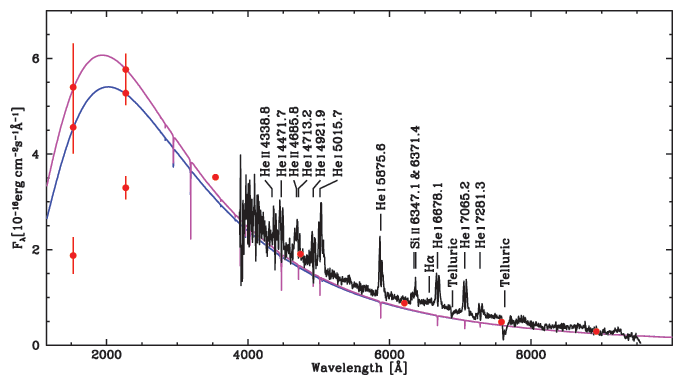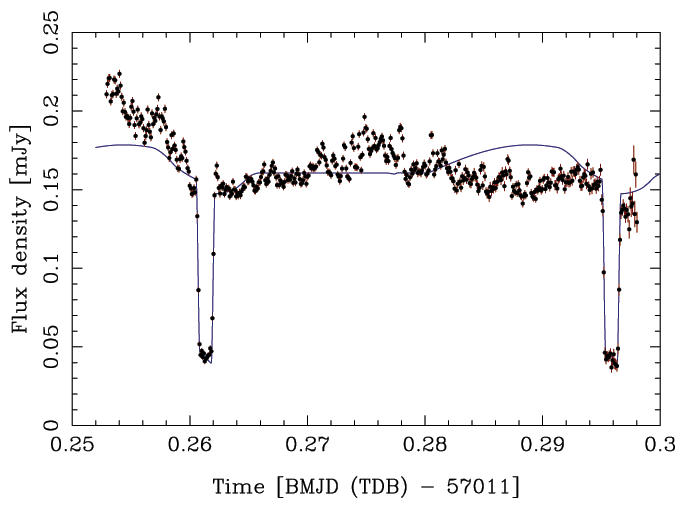Ground-based data processing and follow-up observations
Now the first, proper science-processing begins. SOC passes the transit data though the software pipeline called Initial Data Treatment (IDT), which makes the first estimates of the brightness and position of each star. To get the brightness, IDT has to distinguish the light recorded from the star from the light recorded from the sky background, and this is a complex calculation because the background changes as Gaia spins. To get a position, IDT measures where the star's image falls inside its detector-window across the scan and when the star's image was seen to cross particular points on each detector. IDT then constructs a mathematical model of Gaia's "attitude" — where each of Gaia's telescopes was pointing at the time of the observations — and uses this to work out the star's position on the sky from the position and timing on the detectors. Finally, IDT matches the transit to Gaia's catalogue of light sources (i.e. stars and similar objects). It assigns a catalogue source to each transit, recording a new source in the catalogue if no close match was found.
New sources are exciting: they may be stars that have brightened from below Gaia's detection limit. In particular, new supernovae show up as new sources.
IDT can extract the details of a star quite quickly and using only a small group of adjacent transits. However, to identify the star in the Gaia catalogue, IDT needs at least 16 hours of consecutive observations. Thus, none of the star data are available for further processing until IDT finishes a processing run on a whole mission-day of observations. When IDT produces its results, roughly a day has elapsed since observation.
SOC merges IDT's output back into the main database and then copies the data to Gaia's outlying data-processing centres. The data-processing centre at the Institute of Astronomy (DPCI), Cambridge, handles the calibration of the photometry (i.e. putting the brightness measurements on a common scale, corrected for the differing behaviours of the many detectors in Gaia) and is also the feeder point for the Science Alerts operation. DPCI sends on the data files to Science Alerts as soon as they are received from SOC; they arrive, typically, about 30 hours after observation.
Inside the Science Alerts processing-cluster, the data are fed to the software pipeline called AlertPipe. Here, the transits are organized into light curves and checked for any significant variations, such as getting twice as bright or more. AlertPipe is run once for every IDT run.
AlertPipe first adds ("ingests") the new transits into a database. Recall that Gaia sees only two transits for a source at a time: this is not enough information to justify an alert. Therefore, AlertPipe has to retain all the transits from the mission and to build up the light curve of each source since the mission's start.
After ingestion, AlertPipe checks the light curves of all sources that have received new transits in the current run. First, a calibration is applied to the brightness measurements to improve the accuracy. Next, AlertPipe checks the brightness in the new transits against the average brightness in the history of the source. Three conditions can trigger "detection" of a transient event: a source appearing where none was seen before (for this, AlertPipe works out where Gaia has looked in the past and seen nothing); a source that changes brightness grossly, by two magnitudes or more; or a source that changes brightness more subtly, but enough that the apparent change cannot be due to measurement errors. Any star that meets one of these conditions is called an "alert candidate" and gets closer attention within the Science Alerts group.
When we have an alert candidate, we want to know what kind of star it is: we want to classify it. AlertPipe makes an initial classification automatically, just from the information received from Gaia. The shape of the light curve gives some clues: e.g. most supernovae appear as new sources and a source that dims might be some kind of eclipsing binary. The shape of the spectra from the Blue and Red Photometers is also important; these spectra can distinguish different kinds of supernovae. Large variations in the position suggest that the alleged "star" is actually a solar-system object such as a near-Earth asteroid. Finally, AlertPipe looks for the star in catalogue of objects seen by other space missions and by ground-based telescopes: sometimes Gaia can re-observe and confirm a candidate supernova first seen by others.
AlertPipe takes a few hours to process a run. Alert candidates and their initial classifications typically become available within 36 hours of observation.
Once the candidate is confirmed to be potentially worthy of an alert (we do not alert on solar-system objects or variable stars with stable, repeating light-curves), it is put on a list for human checking and publication. Those candidates approved are made available to everybody (at http://gsaweb.ast.cam.ac.uk/alerts/). When all is working well, we publish alerts less than two days after their triggering observations. All the alerts are given a systematic name, starting with Gaia15aaa for the first alert in 2015, then proceeding to Gaia15aab, Gaia15aac, etc.
Publication of the alert is the climax of the Gaia Science Alerts process; but the story does not end there. The scientific value comes from the follow-up observations. Gaia cannot go back to observe interesting objects selectively, so the follow-up is done with other telescopes, mainly on the ground. All objects seen by Gaia are 20th magnitude or brighter, and can be seen in 2m-class telescopes. Some alerting objects are bright enough for 1m-class telescopes. A few are particular bright and can be observed in smaller telescopes.
One valuable way of following up is to take a classification spectrum at a higher spectral resolution than the spectra supplied by Gaia (resolution is the degree to which the different wavelength of light are spread out; higher-resolution spectra show more detail, but more light must be collected to make them and this needs a bigger telescope).

Spectrum of Gaia14aae. The spectrum was taken on 13 October 2014 the 4.2-m William Herschel Telescope (WHT). (Image credit: Campbell, HC et al, 'Total eclipse of the heart: The AM CVn Gaia14aae / ASSASN-14cn', Monthly Notices of the Royal Astronomical Society (2015).)
With moderate resolution (better than Gaia’s spectra, but something that can be done on a medium-sized telescope), we can measure the spectral lines to find out what is going on in the source. For example, the double-peaked lines in the spectrum of Gaia14aae immediately reveal an accretion disk, and the absence of lines from hydrogen ions show a highly-unusual chemical composition. In fact, this system turns out to be a cataclysmic variable of the AM Canum Venaticorum (AM CVn) class, a very rare kind of star (see "Gaia satellite and amateur astronomers spot one in a billion star" for more information about Gaia14aae).
Another kind of follow-up is to measure the brightness more frequently than Gaia allows.

Light curve of Gaia14aae. The observed WHT light curve (dots), showing eclipses, with a theoretical light curve of the best fitting model (line) comprising of a White Dwarf (which is the main contributor to the light), accretion disc and bright-spot where the gas stream hits the disc. (Image credit: Campbell, HC et al, 'Total eclipse of the heart: The AM CVn Gaia14aae / ASSASN-14cn', Monthly Notices of the Royal Astronomical Society (2015).)
Brief changes in the light curve can be very revealing. For example, Gaia14aae, observed from the ground, shows eclipses that did not show up in the Gaia data. The eclipses happen because Gaia14aae is a binary system and the orbits one star about the other stars is aligned so that they move in front of each other, as seen from our solar system. Gaia14aae is the only fully-eclipsing AM CVn system found so far, by any survey.
Anybody may follow up a Gaia alert, and amateur astronomers have a good chance to contribute (the eclipses in Gaia14aae were found by an amateur team). If you have access to a suitable telescope why not pick an alert and get involved?
Previous: Gaia observation
